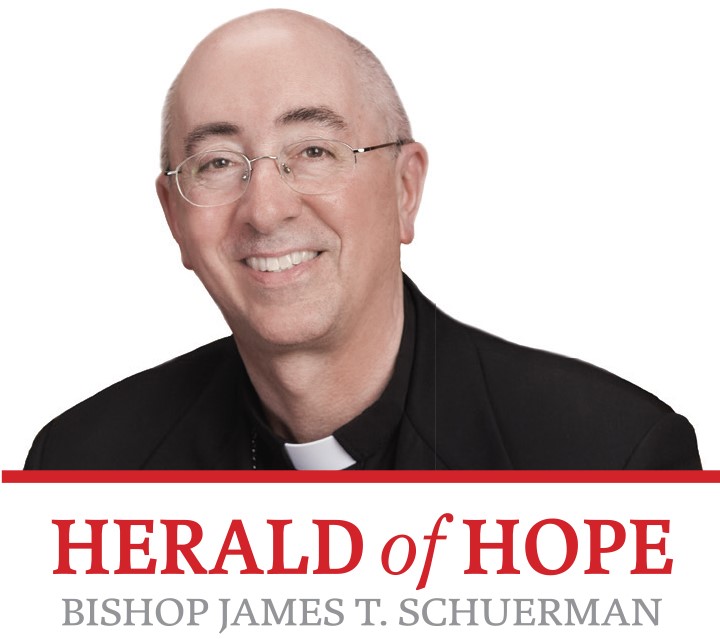Every year, the Church seeks the special intercession of the Mother of God in the month of May. On May 1, the bishops of the United States re-consecrated our nation to Our Lady under the title, “Mary, Mother of the Church.” Archbishop Jose Gomez, president of the United States Conference of Catholic Bishops, led the consecration. Simultaneously, Archbishop Jerome E. Listecki, accompanied by Bishop Jeff R. Haines and me, led a prayer service in the Cathedral of St. John the Evangelist, joining Archbishop Gomez in seeking the Blessed Mother’s intercession for the protection of the vulnerable, the healing of the sick, and wisdom for those working to cure the COVID-19 virus.
During the month of May, I have spent some time contemplating the Canticle of Mary, also known as the Magnificat, found in the Gospel of Luke. (Luke 1: 46-55) I would encourage you to open your Bible to this passage to read and reflect upon the words of this beautiful Canticle.
Not long ago, I led a retreat in Spanish, and one section of the retreat focused on the Magnificat. In preparation for that talk, I read a book by Carlos Mesters called Maria, La Madre de Jesús, (Mary the Mother of Jesus). This book inspired the reflections in this article. (See Carlos Mesters, Maria, La Madre de Jesús, México: Dabar, 1992.)
The Gospel according to St. Luke portrays Mary as a person who understands the Word of God. To be able to proclaim the words of a prayer like the Magnificat, it would be necessary for her to know and understand the stories of the Sacred Scriptures. Luke’s Gospel presents Mary as a person who listened to the Word of God and meditated on it in her heart.
Mary understood the story of salvation as her own story. She understood Abraham as a person of faith, trusting in the promises of the Lord. She understood that God liberated his people from slavery under Pharaoh, and guided them to the Promised Land. She understood that God accompanied his people in difficult times, giving them enlightenment and hope through the words of the prophets. From the Scriptures, Mary learned that God loves the poor and the humble, and that he will raise them up.
Mary recognized the Word of God at work not only in the Scriptures, but also in her own experiences. Her understanding of the great deeds of the Lord in Scripture helped her to trust in the Word of God communicated to her by the angel, that she would be the Mother of the Messiah. She trusted in the God of the Scriptures and the God of her experience. She was a person who heard the Word of God and trusted.
Her acceptance of the Word of God in her life did not separate her from the people. On the contrary, it made her more attentive to the needs of others. For example, the angel Gabriel in the moment of the Annunciation informed her that Elizabeth, her relative, in her advanced age was with child. (Luke 1:35-37) Mary, knowing that Elizabeth would need her help, set off for Judea, about 100 miles from Nazareth. (Luke 1:39-40)
As she proclaims the words of her Canticle, it is clear that Mary identifies herself with the poor and the humble. She praises the Lord, because he has considered her in her humility. As she grasps God’s plan for her, she calls herself “the handmaid of the Lord.” (Luke 1:38) She understands well that God is working marvels through her, and that he alone deserves praise. In the Magnificat, there is an essential connection between humility and holiness, and Jesus, in his ministry, will speak to this truth: “He who exalts himself will be humbled, and he who humbles himself will be exalted.” (Luke 14:11)
Mary was neither rich nor powerful, and the Magnificat demonstrates that she identified with the poor, the hungry, and those who fear God. (Luke 1:52-53) She was a woman of the people, and she carried with her the same hope, the same faith and the same love that the people did. Her Canticle is a prayer of joy, hope and gratitude.
St. Luke, in the Acts of the Apostles, portrays Mary, after the Ascension of the Lord, as being with the Apostles in the upper room, where they had been staying during the Lord’s Passion. St. Luke says, “All these devoted themselves with one accord to prayer.” (Acts 1:14a) In this way, they awaited the coming of the Holy Spirit. On the day of Pentecost, the Holy Spirit descended upon them in abundance and the Church was born.
In 2018, the Congregation for Divine Worship and the Discipline of the Sacraments implemented Pope Francis’ decision to inscribe the Memorial of the “Blessed Virgin Mary, Mother of the Church” in the General Roman Calendar, observed on the Monday following Pentecost. This year, the Memorial falls on June 1. “Mary, Mother of the Church, pray for us.”
